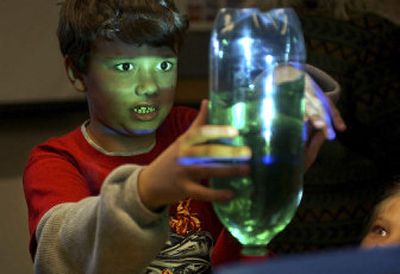Snow, rain, sleet and heat – weather center explains all

Norma Booher takes the weather very seriously.
For 35 years, she has measured the rain and snow, and each day she takes the highest and lowest temperatures, recording all her observations on paper.
“It’s just too much fun,” said the 79-year-old Smyrna, Wash., resident, whose fascination with weather conditions began in her childhood when she chased tornadoes in Iowa.
Booher isn’t just a weather buff, she’s also one of the National Weather Service’s co-operative observers – volunteers who help the agency collect data on local conditions.
At an open house Saturday, the agency’s regional office honored some of its longstanding volunteers such as Booher and gave the public the chance to tour the facility on North Rambo Road near Airway Heights. Almost 200 people attended the event.
Meteorologist-in-Charge John Livingston said the staff wanted to educate people about the federal agency and allow them to see their tax dollars at work.
“People don’t know what we do. When you ask them about the weather, they say they get it from TV,” Livingston said.
Weather fanatics and the simply curious saw an array of instruments at work – radar, satellite, computer and weather balloon data are just some of the components that go into daily weather reports. Several weather balloons were launched; the balloons, which are normally sent out at 4 a.m. and 4 p.m. each day and reach 100,000 feet, measure temperature, humidity and air pressure, Livingston said.
“We have this constant stream of information coming in,” said Senior Meteorologist Robin Fox, who explained the significance of different radar and satellite colored images. Fox said new technology has been implemented at the center that has increased the speed and efficiency of weather reports.
The center, one of 119 offices nationwide, covers Eastern Washington and North Idaho, from the northern Cascades in the west to the Bitterroot Range to the east, and from the Canadian border in the north to the Camas Prairie in the south. Weather forecasts are distributed to different media outlets, and the agency also operates the National Oceanic and Atmospheric Administration Weather Radio. The National Weather Service is the sole source for official warnings for major meteorological events, according to information provided by the agency.
Nonetheless, even with the best technology, the agency depends on regular people to collect data on the ground, especially in remote areas. It has a network of spotters and co-operative observers – the spotters call in observations during conditions such as storms, while observers record high and low temperatures and precipitation on a daily basis.
Spokane’s regional center depends on almost 60 observers and about 500 spotters.
Two volunteer observers received the John Campanius Holm Award for nearly 40 years of exemplary service.
The Galbreath family from Ritzville received one award. Wheat farmer Garry Galbreath said three family generations have recorded the weather.
“It’s been interesting. … Weather has a big impact on what we’re trying to do,” said Galbreath.
John Hofmann, of Rosalia, who began making observations in 1969, also received the award. Booher and Harry J. Vaughan of Spokane received awards for 35 years of service.
The open house was not only fascinating for the old, but the young as well.
Seven-year-old James Terry, of Spokane Valley, spent well over an hour looking at satellite and radar images and asking questions.
“I watch the weather every day,” said James, a devoted fan of the Weather Channel. “I like the sunny weather, because it’s warm.”
“We bought him a lot of books about tornadoes and storms,” said his mother, Becky Terry. “He looks at the sky and tells us what kind of clouds they are.”
Terry said she and her husband are thinking of signing James up as a spotter.
From the sound of things, James already knows his weather.
“That’s a hurricane right there,” he said pointing to a gray swirl on the radar of Hurricane Otis, which is developing near Baja California. “Hurricanes usually form in the Atlantic.”